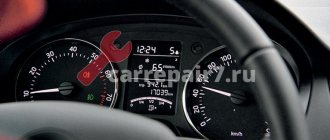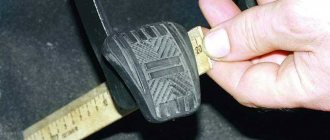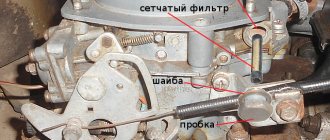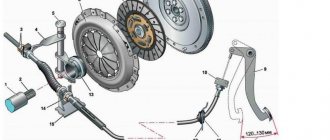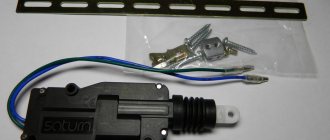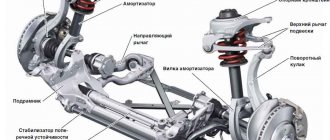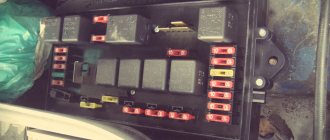The operation of the multi-stage gearbox mechanism is impossible without the coordinated actions of the clutch mechanisms. The start of movement and the braking process of any brand of car are carried out using these parts. The clutch pedal of Lada Priora, Tavria and other cars is suspended on an axle and is attached to the body using a bracket. Its service life depends on the correct position of the driver in the cabin. You should not keep your foot on the pedal for a long time, because the increasing load reduces the life of the clutch mechanisms.
Clutch pedal squeaks - prerequisites and methods for solving the problem
Hi all. Not long ago I talked about the reasons for the failure of the clutch pedal, as well as methods for solving this phenomenon. Now I’ve decided to supplement the series of articles on the clutch with another, no less pressing topic - the creaking of the clutch pedal.
You will learn about the reasons why the clutch pedal squeaks and how to get rid of it.
I’ll say right away that the creaking of a pedal, whether it’s a clutch or a brake, almost always does not affect its functionality and, by and large, is an ordinary irritant that infuriates almost all motorists. The creaking or grinding of pedals occasionally indicates serious breakdowns, but before you give up on it with the words “I still have nerves of steel,” I recommend making sure that the problem is really not worth attention.
When is adjustment of the clutch drive mechanism necessary?
Despite the presence of innovative ideas in the field of transmission control, Togliatti automakers still recommend checking the condition of the ratchet mechanism at every maintenance. In addition, it would be a good idea to pay attention to the signs that indicate problems with the clutch control system:
- Loss of traction due to unreliable connection between the flywheel and the disk.
- “Sagging” of the clutch pedal.
- Difficulty changing gears.
- Extraneous sounds when using the clutch pedal.
Clutch pedal creaking - prerequisites
The main prerequisite in the vast majority of cases is the drive, which can be either mechanical or hydraulic. The force you exert on the pedals is transmitted to the clutch fork by means of a cable or hydraulic system. Despite the fact that hydraulic and mechanical drives have different designs, their creaking is monotonous. On models such as: VAZ 2110, 2112, 2114, 2115, a mechanical cable clutch is installed. In some models, in order to compensate for friction lining wear, the manufacturer installs a mechanism that does not require adjustment. This clutch is equipped with: Priora, Granta, and also Kalina.
When the driver notices that the clutch pedal is creaking, this already means that the problem has reached a certain point. Creaking is associated with excessive wear of working parts (for example, the fastening mechanism), water ingress on rubbing surfaces, and other reasons for which increased friction occurs. Often, pedal squeaking occurs due to the return mechanism.
Such sounds most often appear not when pressing, but when releasing the pedal, just at the moment when the clutch mechanism is released from overload. If we talk about the pedal assembly, then only mechanical connections and the return spring can creak there. The problem of the creaking itself is unpleasant because it is very difficult to get to the pedal block. Working in a confined space is not easy, because the work requires a lot of strength and patience.
The clutch pedal squeaks due to wear on the mounting mechanism. For most VAZ models, the pedals are mounted on hinged mounts and axles. Either a plastic bushing or lubricant is responsible for the pedal sliding on the axle. By and large, plastic bushings do not anticipate the presence of lubricant, but if you still add it, it won’t be worse. A squeaking clutch pedal can appear even on the newest cars, in which everything is working properly. You can remove creaking and grinding noises by applying lubricant or replacing the bushing and spring; the most important thing is to find where exactly the creaking is coming from. The lubrication itself is carried out after complete dismantling of the pedal block together with all mechanisms. The work is complicated by the fact that the dismantling process takes a lot of time and is considered very labor-intensive. If you don't want to remove all the pedals, you can try lubrication using a syringe. Apply oil to the rubbing parts, inside the bushings, and also where you think it is necessary. We remove the remaining lubricant with a rag, after which we check whether the clutch pedal squeaks or not.
If after lubrication nothing has changed, you can imagine that the reason is in the return spring. The spring may hit something or creak on its own. We lubricate the spring, if necessary, with silicone grease or WD-40, but the effect will most likely be short-term. Therefore, it is better to use the most severe lubricants such as graphite or CV joint lubricant.
The cable creaks. In some cases, creaking, grinding and clicking noises are associated with disturbances in the operation of the mechanical drive. The problem in this case is that the cable can creak both outside and inside the cabin. Full lubrication of the cable along its entire length will help correct this situation. The procedure is not difficult and does not take much time, so if this is the reason, then you can consider yourself lucky. For convenience, the cable is disconnected from the clutch fork, after which it is lubricated from the engine compartment. If the cable is old and shows signs of wear, lubrication is unlikely to be advisable, it would be better if you completely replace the clutch cable. Unprotected working surfaces of the cable that are outside the protective casing should be lubricated with waterproof grease.
The creaking of the compensatory mechanism. If the car has such a mechanism (it is located under the hood or near the pedal), the new cable can make unpleasant sounds and clicks, similar to squeaking or grinding. The problem in this situation is due to the fact that the mechanism is not worn in and requires lubrication of the compensation mechanism.
If the creaking of the VAZ clutch pedal is not associated with any of the problems listed above, there is a suspicion that unpleasant sounds are generated in the crankcase area. Such a squeak can be produced, for example, by the clutch fork. The difficulty in this situation is that it is possible to check whether the problem is or not only after completely dismantling the clutch. There are indeed some tricks like lubrication without removal, but they require certain skills and accuracy. The trick and dexterity lies in the ability to lubricate the fork with oil without removing the checkpoint (Checkpoint - a point designed to control passage (visit) and access to the territory of any facility)
. But if it is not the fork that is creaking, but another mechanism, the quickest way is to remove it.
The fork is lubricated as follows. We take out the rubber plug, then fill the syringe with lubricant and carefully apply a few drops to the clutch fork axle. For cars whose forks do not have an axle, lubrication occurs slightly differently. Using a strong screwdriver or mounting tool, the fork is moved to the side, after which it is lubricated with a thick lubricant like “Litol” at the point of contact of the fork with the rod.
Source: vaz-remont.ru
Clutch pedal creaking on the latest Priora
Because you are not authorized on the website. To come in.
Because you are not a trusted user. How to become a trustee.
Because The topic is archived.
Because you are not authorized on the website. To come in.
Because you are not a trusted user (phone number not verified). Enter and confirm your phone number. Read more about trusts.
Because The topic is archived.
Because you are not authorized on the website. To come in.
Because you are not a trusted user (phone number not verified). Enter and confirm your phone number. Read more about trusts.
Because The topic is archived.
Because you are not authorized on the website. To come in.
Because you are not a trusted user (phone number not verified). Enter and confirm your phone number. Read more about trusts.
Because The topic is archived.
Because you are not authorized on the website. To come in.
Because you are not a trusted user (phone number not verified). Enter and confirm your phone number. Read more about trusts.
Because The topic is archived.
Because you are not authorized on the website. To come in.
Because you are not a trusted user (phone number not verified). Enter and confirm your phone number. Read more about trusts.
Because The topic is archived.
Because you are not authorized on the website. To come in.
Because you are not a trusted user (phone number not verified). Enter and confirm your phone number. Read more about trusts.
Because The topic is archived.
Because you are not authorized on the website. To come in.
Because you are not a trusted user (phone number not verified). Enter and confirm your phone number. Read more about trusts.
Because The topic is archived.
Advertisements on NN.RU – Auto
Extend the chassis (frame) on Gazelle Next, Gazelle peasant under a body of 4.2 m, 5.1 m and 6.2 m. Extend the frame on Gazelle Next, Gazelle Gas 3302. Cost: 25,000 rubles.
A wide selection of hydraulic pumps and hydraulic motors of all series: spline hydraulic pump of right rotation. It is used in road construction and... Cost: 1,000 rub.
A special enterprise for the conversion of cargo vehicles produces extensions of the man man, iveco iveco truck tractor.
A special enterprise for converting cargo vehicles into a tow truck invites you to install a tow platform on.
Source: www.nn.ru
List of online stores selling parts (Moscow, St. Petersburg, Kyiv regions)
| № | Name | Address |
| 1. | "Autoall" | www.avtoall.ru |
| 2. | "Original part" | lada-original.ru/ |
| 3. | "Navigator" | www.navigator-63.ru/ |
| 4. | "TOTAX" | totax.com.ua |
| 5. | "Zakupka" | kiev.zakupka.com |
| 6. | "How much" | www.avtostore.spb.ru |
Recommendations
Comments 25
Now I tried it, it didn’t help (( Granta Drive Active 60,000 mileage
A week later I started clicking again. Not so long ago I was driving a Datsum taxi, it clicks like crazy and I sold it to Grant for fuck's sake
There is an opinion that after such improvement the clutch cable breaks after a certain time. I don’t understand whether it’s a coincidence or not, but my cable broke in this particular place, a couple of months after installing a piece of metal-plastic there. Although I can say in support that there are no more clicks. And at the moment, even the newest one does not crunch))
Crunched up to 47 thousand km. Later, it can crunch and there are no more clicks or crunches. Everything became soft and quiet on its own
Curious... My mileage is 43 thousand km. It was necessary to wait))) for the sake of enthusiasm, I’ll take it out in a month and check it.
I’m not saying anything)) it happened to me personally)) I don’t even understand whether this will happen to you or not)))
There was also such a failure. I changed the spring to a stiffer one. It's been quiet for six months now
Yesterday I set the gap to 27 mm and everything worked. It works unsurpassed
I will inspect the gap and pull it out for testing.
I had enough for a week
A week has passed, everything is ok. I read reviews of people who have been riding for 2 years and everything is ok. You will also need to check the 27mm gap.
I generously lubricated the ratchet mechanism with graphite lubricant from Oilwright. Contributed
Lubricated it didn't help. But it slightly relieved the squeak; after all, the hose does not eliminate the squeak, but eliminates the clicks and gives softness to the pressure because the angle of travel of the cable changes.
This method is not for everyone, it didn’t work for me, I changed the cable to a new one, after 3k the same picture happened again. In the photo, 3 machines click, and the 1st one has an automatic machine.
I read your review. Well, the video helped me. Apparently it works for someone and everything is ok, for someone it doesn’t work and there’s no way to fix it.
Before I got behind the wheel of the Granta, I read the primer for it. The clicking noise is produced by the automatic wear compensator for the disc linings and the cable pull. It clicked once a day for about two weeks, at the moment if it clicks once every six months that’s all. Did not do anything!
I read your commentary before installation. Specifically, clicks and not clicks, I have one now and listen to the video, but earlier everything creaked and clicked. I've been driving for 2 months and it's constantly clicking and from time to time it even feels like the plastic is breaking with a crunching sound being squeezed out. At this point, a week has passed and everything is ok. And one of the main advantages was the soft pedal. We simply change the angle of travel of the cable, but not the most.
My pedal was always soft, there were clicks (on the newest one) once per squeeze. When I worked as a driving instructor, there were also clicks all the time, but one at a time, not the most.
Right now I also have one for the squeeze. Well, I heard it myself.
I set the gap to 27 mm and filled the ratchet mechanism with oil from a syringe and silicone from a balloon. There were no clicks at first, and there was no creaking.
Source: www.drive2.com
Consequences
This operation does not cause any negative consequences. As the clutch discs wear, the rod will gradually come back out. However, when new clicks begin, the time will come to change the clutch itself.
The design of the Priora clutch drive cable can be seen in the video:
- Vehicle track width: determine correctly
- Homemade strobe for setting the ignition
- How to make a car strobe light with your own hands
- Vehicle understeer and oversteer
Clutch pedal on Priora
November 4, 2008, 16:00 #1
I bought the car in the middle of December last year. Now the mileage is 1800 km. Right now there is such a problem that when the car warms up and moves a little, then later the clutch pedal begins to click when it is released completely. Has anyone encountered this and can you tell me what it could be?
February 6, 2009, 00:26 #2
I bought the car in October 2008. The clutch pedal started clicking when pressed after a month. This is the fastest pedal mounting bushing, but I haven’t looked at it myself yet. Whenever I see it, I’ll say it literally.
February 23, 2009, 16:42 #3
Men, I have the same thing, the clutch pedal clicks, I don’t understand what to do! Tell me something?
February 23, 2009, 16:45 #4
there is a piece of plastic there that pulls the cable, so it clicks
23 February 2009, 19:41 #5
Over time it will get used, and virtually no clicks will be heard.
23 February 2009, 21:26 #6
I also had clicks. It passed {by itself} and I didn’t even see it.
Naberezhnye Chelny RT
February 23, 2009, 10:03 pm #7
And I also have this problem, which periodically arises and disappears.
24 February 2009, 19:19 #8
It seems like it’s global, it also clicks for me from time to time.
March 2, 2009, 13:21 #9
I’m not the only one whose pedal clicks in a Prior, I was told that when it clicks, the clutch cable is stretched, like a car. I don’t understand whether this is true or not.
Vsevolozhsk Len. region
March 3, 2009, 5:22 pm #10
It really clicks when you're stuck in traffic jams. I lubricated the bushing and cable with CV joint grease - it became a little quieter and that’s it. Literally globally.
Clutch on Priora: device and mechanism of operation
The operation of the multi-stage gearbox mechanism is impossible without the coordinated actions of the clutch devices. The start of movement and the braking process of any brand of car are carried out using these parts. The clutch pedal of Lada Priora, Tavria and other cars is suspended on an axle and is attached to the body using a bracket. Its service life depends on the correct position of the driver in the cabin. You should not keep your foot on the pedal for a long time, because increasing overload reduces the life of the clutch devices.
Priora clutch device
The short-term connection between the motor and the gearbox when changing gears and for the constant transmission of torque when the car is moving makes the clutch. The box remains intact and is subject to overloads. Clutch designs are frictional, hydraulic and electromagnetic.
The most common type is friction. It is located under the hood of the car. Magnetic polarity is used by electromagnetic, and working water pressure is used by hydraulic. The clutch mechanism includes the following parts:
- basket;
- pressure plate assembly;
- driven disk;
- release bearing.
Any car has a dry-type single-plate clutch with a central pressure spring, which is disengaged using a backlash-free cable drive with an automatic cable adjustment mechanism. The basket is a metal case containing a diaphragm-type pressure spring and a disk mounted on 3 pairs of plates. The basket is attached with 6 bolts to the flywheel and locked with a duralumin crater.
The upper part of the clutch pedal resembles a double-armed lever with a finger at the end. The drive cable for turning off the part is connected to it. The length of the cable is adjusted by a ratchet mechanism. The cable is in an iron sheath and has a polyethylene coating. Using a bracket, which serves as a travel limiter for the clutch pedal, its upper end is attached to the pedal assembly. A corrugated cover covers the lower end of the cable.
It is engaged using a fork that rotates in two bushings. The upper one can be removed, but the lower one is tightly pressed into the clutch crater. When turning the fork, the driver makes a force directed at the pressure spring through the ball bearing. It is located on the clutch release clutch and is connected to the drive fork using a U-shaped spring. In a Priora car there is a sensor that will best show clutch faults.
Features of the Lada Priora clutch
Any motorist interested in how to adjust the clutch on a Priora should know about the presence of the drive cable auto-adjustment function. That is, VAZ designers took care of the owner and saved him from the need to constantly adjust the clutch drive mechanism during operation. The same ratchet-type system is installed on Kalina , but both there and on Priora it is impossible to do without periodic adjustments. This factor has been proven by practice and forum discussion pages.
How does an automatic cable tensioner work?
In the release drive on the VAZ 2170, there are no gaps as a concept, hence the name - backlash-free clutch. The ratchet mechanism serves to compensate for the working length of the cable as the driven disk linings wear out. To understand the process, it is important to accept the following data:
- During operation, the driven disk wears out and its linings become thinner - as a result, the release bearing and basket springs shift towards the gearbox.
- Accordingly, the fork at the place where the cable is attached moves towards the radiator.
- The spring located on the bushing of the adjusting mechanism is compressed at this time and tightens the clamps of the cable tip.
- As a result, the tip is pulled out of the driver, due to which the wear of the disc linings is compensated.
For those who don’t yet know how to adjust the clutch on a Priora themselves, it is important to take into account the moment when the linings are new. In this case, when releasing the pedal, the ratchet bushing will only lightly touch the bracket without releasing the clamps. Therefore, the toothed tip of the cable will not move relative to the housing. Only as the linings wear out does the spacer sleeve release the spring-loaded clamps and the cable tip extends to the amount necessary to balance the worn parts.
Troubleshooting clutch problems
The prerequisite for an uncomfortable ride and the beginning of the moment of movement is a very tight press or, even worse, a loose clutch pedal, which can lead to the creation of an emergency situation on the roads. What is better: replacement or repair?
The design feature of the clutch is such that when the angle of inclination of the disc spring changes during wear, it is necessary to use more force to press. With all this, the cable may break, the release bearing may break, and the clutch pedal clicks and creaks. All these problems can be eliminated.
To change the cable, it is better to first remove the air filter. Using keys, remove the cable together with the wiring from the groove of the lever. To make repair work easier, it is better to start by pulling the clutch pedal towards you and removing it. Now you can freely remove the cable sealing cover and remove the wiring from the tip. When reinstalled, its end should be at the same level as the new, working one.
It wouldn't hurt to know
What do most owners of new Lada Priora do? Naturally, they treat the body with Movil or something similar against corrosion; they don’t have any more problems at the initial level. However, there were complaints about squeaking when pressing the clutch pedal; sometimes it was present when the engine was warm, sometimes only when it was cold - the essence is that there is a problem.
Of course, everyone immediately starts reading the “primer book” on how to correctly adjust the clutch on their Priora, which sometimes helps, but the fact of the matter is that sometimes. After this, owners can try several more methods, after which the squeak may disappear:
- Replace the drive cable, some drivers praise the “tenth”.
- Check the presence of a spring in the automatic tension mechanism; sometimes the effect can be achieved after replacing the standard part with a spring with greater elasticity.
- A certain percentage of car enthusiasts get rid of the crackling noise by lubricating the fork and the plastic cable nut.
- Lubricate the installation site of the plastic bushing on the pedal bracket with lithol.
- Remove the boot from the fork lever and lubricate the gearbox input shaft with graphite grease from a can.
It is worth considering another effective method, shown in the video, which is used by experienced car enthusiasts. Its essence is as follows:
- Disconnect the mass air flow sensor and remove the air filter.
- Remove the clutch release rod plug.
- Release the cable from the clutch fork.
- Pour 30-40 ml of gear oil from a syringe.
- Move the fork back and forth 10-15 times.
- Reinstall the cable, plugs and filter.
Using the example of the second part of the article, it becomes clear that adjusting the clutch drive does not always bring the desired effect in the fight for acoustic comfort. Although, from a technical point of view, the procedure is necessary, since it ensures productive operation of the car.
Clutch sensor
It happens that when switching gears, the machine for some reason begins to jump and twitch. The same signs are observed at low speeds. The whole reason is that the clutch sensor is faulty. It is located in the cabin, at the place where the clutch pedal axis is attached, and only on those cars that use E-gas. They often lack a throttle position and idle speed sensor.
A magnet that rotates with the drive gear and a Hall sensor in the amount of 2 pieces, which convert the magnetic field configurations into an electronic signal and transmit it to the control unit, these are the components of the clutch sensor. With the help of such a signal, the electrical unit can show a real picture of the magnitude of the clutch stroke. The sensor works on the same principle as the gear shift indicator.
When driving, there is an overload on the clutch pedal, a signal about the state of which will be transmitted by the sensor. It will determine the speed of rotation of the crankshaft and the engaged gear. If such a signal is not received, then it is time to change the sensor. A break, a short circuit in the electronic circuit, an abnormal clutch pedal height, a malfunction of the switch - all these characteristics can be tracked by the sensor using a signal.
Free play of the clutch pedal
From time to time you can hear the clutch pedal clicking, or suddenly see that it is not fixed and dangles, creaks unpleasantly. Why? There are several circumstances.
Cause
| № | |
| 1 | Malfunction of the plastic bushing |
| 2 | Wiring tip requiring lubrication |
| 3 | Lack of lubrication of the input shaft in the box |
| 4 | Pressed driven disk |
The cable, backlash-free clutch release drive of the Lada Priora has a ratcheting mechanism. With all this, adjustment is absolutely not necessary for operation. This mechanism has a small switch that makes a click, literally like a computer mouse. You can adjust the cable yourself, and the clicks will disappear on their own.
A more common reason for a squeaking pedal is lack of lubrication. It can be solved by purchasing graphite lubricant in a can and painstakingly processing the parts. The Priora manufacturers modified the cable tensioning mechanism and installed a small spring on it. If lubrication is lost, it causes a certain sound when pressed. The cable mechanism is also equipped with an iron bracket, which, under certain operating conditions, causes clicks.
From time to time, when you press the pedal, you can see that it falls down without much effort and does not return to its initial position, or it completely dangles or clicks. This means that the mechanical drive cable has broken and needs to be replaced urgently. Maybe the spring flew off and burst, or the power fork broke. If air gets into the hydraulic drive system, the clutch pedal clicks. In these options, repairs are possible only in service centers or workshops.
Causes of these unpleasant sounds from the car
Oddly enough, the reason for these clicks is one design feature of the VAZ gearbox clutch drive. Namely, the self-regulation mechanism of the tensioner. It is shown in the photo below.
Parts No. 3 and 4 are visible here. Part No. 3 is a rod clamp for fixing No. 4. According to the designers, when the pedal is activated, this rod should slightly lift the cable and fix it in one position on the pedal. However, this, alas, does not happen. But this “tandem” regularly produces loud, unpleasant clicks that get on the nerves of the car driver. When you need to use the clutch, this sound is extremely annoying.
Sachs clutch
The production of clutches for different brands of cars has its own innovations. The clutch, like all other mechanisms, wears out quickly, and any driver wonders how to choose the appropriate mechanism. Driving style and operating conditions are directly proportional to service life. Therefore, the specialists of the Sachs company, taking into account all the wishes of the drivers, released for sale the latest, environmentally tested flywheel, release bearing, clutch disc and slave cylinder, small-sized clutch units and other design solutions that are no less worthy of attention. These new products include:
- MZ type clutch basket with pull-out action.
- XTend with automatic wear compensation.
- Dual-mass flywheel ZMS.
- Release bearing type CSC.
- Ultra-compact clutch unit (for sports cars).
Which clutch to install is up to you, but if the driver takes good care of his own car, a replacement can be created after 100,000 km. The clutch pedal is a typical indicator of the technical condition of the engine and gearbox.
She talks about various defects and asks for prevention and constant control. Competent and correct replacement of the clutch, the introduction of all the capabilities of these designs will extend the life of your car.
Source: 1ladapriora.ru
How to remove crackling, crunching and squeaking noises from the clutch pedal on a Lada Granta
Have a nice day, dear friends. Now we will talk about how to remove extraneous sounds (crunches, squeaks, crackles) when working with the Lada Granta clutch pedal.
Mechanics are a completely “unhealthy” topic for a Russian car produced by VAZ. While making generally reliable and undemanding gearboxes, assemblers make mistakes from time to time: they set the clutch pedals incorrectly, skimp on lubricants on the working elements of the devices, and disrupt technological processes.
As a result, the user must encounter extraneous noise when working with the clutch pedal and the gearbox as a whole. Now I will tell you what to do if the clutch pedal crunches or makes other nasty sounds.
Answers (3)
Lubricate the clutch pedal cable, or change the cable itself. Or do nothing. My pedal squeaked on my Opel. I sprayed WD-40, but it didn't help for long.
Lubricate these places on the clutch pedal assembly with lithium grease - look at the photo
What helps is to place a piece of hose under the cable. Only 5-6 cm of hose. There is one in the photo.
Where to put the hose
How to remove extraneous sounds from the clutch pedal on a Lada Granta?
As everyone understands, the clutch cable drive circuit on the Lada Granta is equipped with an automatic tensioner (wear compensator) of the clutch cable.
As conceived by the designers, such a scheme simplifies the operation of the car; the owner no longer needs to independently adjust the gap on the clutch fork and adjust the clutch pedal. But nevertheless, difficulties still occur: the clutch clicks or creaks when pressed. Most often, assemblers are to blame for incorrectly setting the working gap on the clutch fork and skimping on lubrication during assembly. As a result, we get extraneous noise when working with the pedal.
In order to deal with the problem, it is necessary to carry out a set of simple measures. First we need to adjust the clearance on the clutch fork. This can be done either with or without removing the air filter housing.
If you decide to remove the filter housing, then you need to: remove the cool air intake pipe and the air supply pipe to the receiver, remove the wiring from the mass air flow sensor, disconnect the wiring harnesses that are attached to the housing and, freeing it from the rubber stops, remove the housing from the engine compartment places.
To set the gap on the clutch fork, you need to pull the clutch cable all the way in the direction of travel of the car, and by unscrewing and wrapping the plastic wing, set a gap of 27 mm between the wing and the clutch fork.
After we have set the guaranteed working gap on the fork, we need to lubricate the elements in the pedal assembly. WD-40 will do the job. We need to lubricate the clutch bushing and the plastic wear compensation ratchet. Also, if necessary, you can apply lubricant to the clutch cable sheath.
By performing this simple series of actions, you are guaranteed to get rid of noise when working with the clutch pedal and set the mechanism to the best level of performance. If the noise remains when you press the pedal, I advise you to contact an official service center, since the presence of such noise after all the necessary work may be a signal of a malfunction that will require replacing the cable or pedal assembly.
Review of Manufacturer Prices
| Manufacturer | Price, rub.) | Resource (Thousand km) |
| LADA 21901-1602210 original | From 634 | 100 |
| ASPCC260210 | From 465 | 75 – 80 |
| BRAND 219011602210 | From 300 | 75 — 80 |
| Plastic cable lead 21901-1602266-00 | From 150 | 40 |
| 21901-1602210-00 clutch cable assembly | From 550 – 600 | 75 |
| 21901-1602210-00 clutch cable assembly | —/— | 75 |
| JSC "ProSport" 26594516 | From 500 | 80 – 85 |
| JSC Vortex 5465465 | From 550 | 80 — 85 |
*prices are current as of October 29, 2018.
Recommendations for the selection of parts and components
The vast majority of spare parts for the Lada Granta are domestically produced. Foreign analogues are not in demand due to their high cost. Compared to “our” products, imports are 10–15% more expensive. The workmanship is at the same level.
When purchasing spare parts and components, always give preference to high-quality, original parts. Check the correspondence of catalog items with the actual data specified in the operating instructions for the technical device.
If you have no experience in car maintenance, seek qualified assistance from service station specialists.
